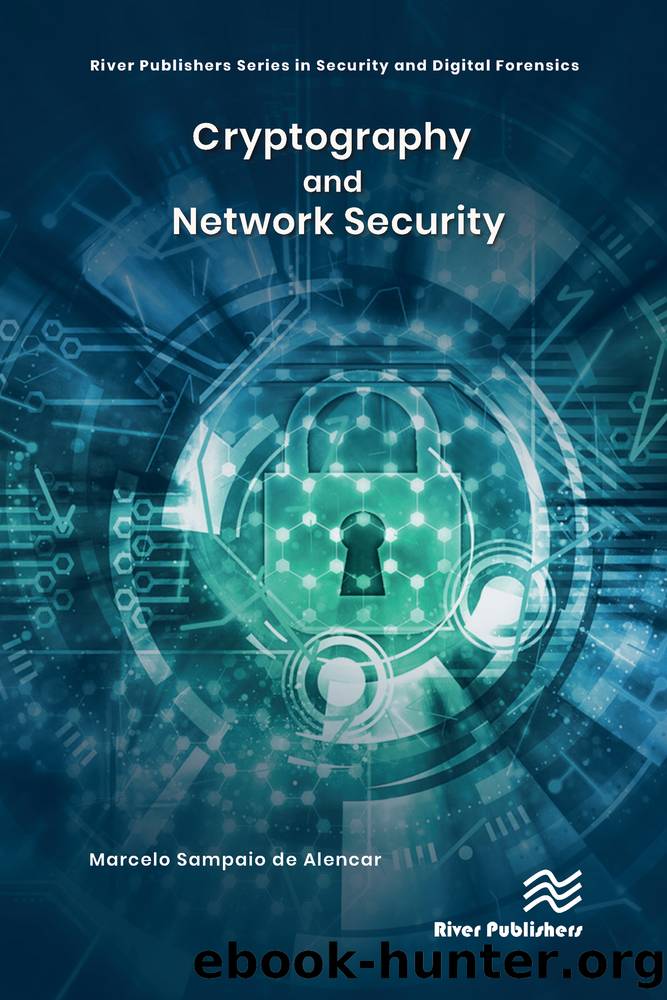Cryptography and Network Security by Marcelo Sampaio de Alencar;

Author:Marcelo Sampaio de Alencar; [de Alencar, Marcelo Sampaio]
Language: eng
Format: epub
ISBN: 9781000796711
Publisher: CRC Press (Unlimited)
Published: 2022-06-15T00:00:00+00:00
Figure 8.3 How the application layer works.
8.8.2 Transport Layer
In data transmission, the transport layer is responsible for taking the data passed through the data layer and application layer and turn them into packages.
TCP is the mostly used protocol in the transport layer. At the reception of data, the TCP protocol takes the packets passed through the Internet layer and puts them in order since the packets can reach the destination out of order, check if the data inside the packets are intact, and send a confirmation signal called acknowledge (ACK) to the transmitter, informing that the packet has been received correctly and that the data is healthy.
If no acknowledgment signal (ACK) is received (either because the data did not reach its destination or because TCP discovered that the data was corrupted), the transmitter will resend the lost packet.
While TCP reorders packets and uses an acknowledgment mechanism, which is desirable in data transmission, there is another protocol that operates in this layer that does not have these resources. This protocol is UDP (User Datagram Protocol).
For this reason, TCP is considered a reliable protocol, while UDP is considered an unreliable protocol. UDP is typically used when no important data is being transmitted, such as DNS requests. Since UDP does not reorder packets or use an acknowledgment mechanism, it is faster than TCP.
When UDP is used, the application that requests the transmission is responsible for verifying that the data received are intact or not and also to reorder the received packets, that is, the application does the work of TCP.
During data transmission, both UDP and TCP receive data passed from the application layer and add a header to that data.
Upon receipt of data, the header will be removed before the data is sent to the appropriate port.
This header contains control information, in particular, the number of the source port, destination port number, sequence number (for acknowledgment of receipt and reordering mechanisms used by TCP), and a checksum (called checksum or CRC, which is a calculation used to verify that the data was received intact at the destination).
The UDP header is 8 bytes, while the TCP header is between 20 and 24 bytes, depending on whether the options field is being used or not.
Figure 8.4 illustrates the data packet generated at the transport layer. This data packet is sent to the Internet layer, for data transmission, or is received from the Internet layer, when receiving data.
Download
This site does not store any files on its server. We only index and link to content provided by other sites. Please contact the content providers to delete copyright contents if any and email us, we'll remove relevant links or contents immediately.
Grails in Action by Glen Smith Peter Ledbrook(9162)
Sass and Compass in Action by Wynn Netherland Nathan Weizenbaum Chris Eppstein Brandon Mathis(8808)
Azure Containers Explained by Wesley Haakman & Richard Hooper(7423)
Configuring Windows Server Hybrid Advanced Services Exam Ref AZ-801 by Chris Gill(7420)
Kotlin in Action by Dmitry Jemerov(7262)
Running Windows Containers on AWS by Marcio Morales(6961)
Microsoft 365 Identity and Services Exam Guide MS-100 by Aaron Guilmette(5388)
Microsoft Cybersecurity Architect Exam Ref SC-100 by Dwayne Natwick(5195)
Combating Crime on the Dark Web by Nearchos Nearchou(4970)
The Ruby Workshop by Akshat Paul Peter Philips Dániel Szabó and Cheyne Wallace(4655)
Management Strategies for the Cloud Revolution: How Cloud Computing Is Transforming Business and Why You Can't Afford to Be Left Behind by Charles Babcock(4521)
Python for Security and Networking - Third Edition by José Manuel Ortega(4226)
The Age of Surveillance Capitalism by Shoshana Zuboff(4207)
Learn Wireshark by Lisa Bock(4096)
The Ultimate Docker Container Book by Schenker Gabriel N.;(3880)
Learn Windows PowerShell in a Month of Lunches by Don Jones(3679)
DevSecOps in Practice with VMware Tanzu by Parth Pandit & Robert Hardt(3558)
Windows Ransomware Detection and Protection by Marius Sandbu(3536)
Blockchain Basics by Daniel Drescher(3495)
